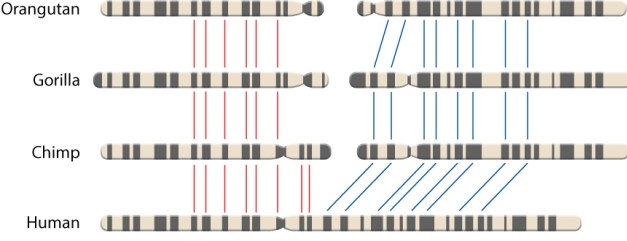Multiple Choice
Consider the figure below showing the arrangement of homologous genes in several great apes relative to human chromosome 2. Red and blue lines between chromosomes connect homologous regions. Do these data reject or support the sister group relationship between humans and chimps?  Data source: Yunis, J. J., and O. Prakash. 19 March 1982 "The Origin of Man: A Chromosomal Pictorial Legacy." Science 215:1525-1530.
Data source: Yunis, J. J., and O. Prakash. 19 March 1982 "The Origin of Man: A Chromosomal Pictorial Legacy." Science 215:1525-1530.
A) These data reject the sister taxa relationship because humans only have a single chromosome and all other great apes have two; these data cannot be used to infer relatedness.
B) These data reject the sister taxa relationship because all the genes that are connected by the blue lines are the same in all great apes.
C) These data support the sister taxa relationship because all genes indicated by red and blue lines in chimpanzees are also in humans.
D) These data support the sister taxa relationship because it shows how the human chromosome was divided in two to give rise to all other great ape taxa.
Correct Answer:

Verified
Correct Answer:
Verified
Q40: The convergent evolution of lactose tolerance in
Q41: Consider the following mtDNA sequences obtained
Q42: When Rebecca Cann decided to conduct research
Q43: Which of the following statements describes Neanderthals?<br>A)They
Q44: Many researchers hypothesize that modern humans have
Q46: Consider the phylogenetic tree shown below. Geographic
Q47: Which of the following is NOT an
Q48: Why do we only see Neanderthal input
Q49: Although we must be cautious about oversimplifying,
Q50: The common phrase "Humans evolved from chimpanzees"